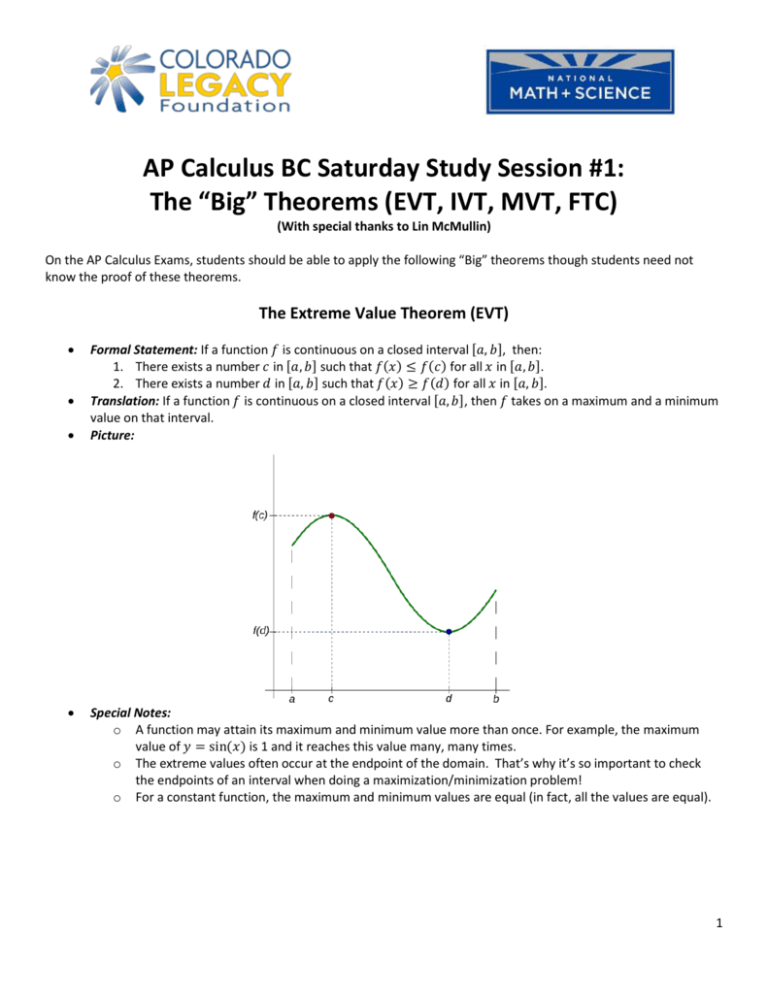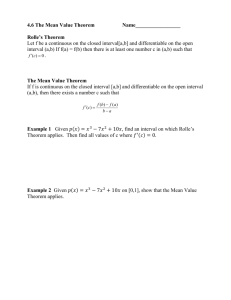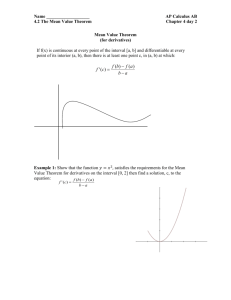AP Calculus BC Saturday Study Session #1: The “Big” Theorems
advertisement

AP Calculus BC Saturday Study Session #1: The “Big” Theorems (EVT, IVT, MVT, FTC) (With special thanks to Lin McMullin) On the AP Calculus Exams, students should be able to apply the following “Big” theorems though students need not know the proof of these theorems. The Extreme Value Theorem (EVT) ], then: Formal Statement: If a function is continuous on a closed interval [ ] such that ( ) ]. ( ) for all in [ 1. There exists a number in [ ] such that ( ) ]. ( ) for all in [ 2. There exists a number in [ ], then takes on a maximum and a minimum Translation: If a function is continuous on a closed interval [ value on that interval. Picture: Special Notes: o A function may attain its maximum and minimum value more than once. For example, the maximum value of ( ) is 1 and it reaches this value many, many times. o The extreme values often occur at the endpoint of the domain. That’s why it’s so important to check the endpoints of an interval when doing a maximization/minimization problem! o For a constant function, the maximum and minimum values are equal (in fact, all the values are equal). 1 The Intermediate Value Theorem (IVT) ] and ( ) Formal Statement: If a function is continuous on a closed interval [ ( ), then for every ) so that value of between ( ) and ( ), there exist at least one value of in the open interval ( ( ) . Translation: A continuous function takes on all the values between any two of its values. Picture: Mean Value Theorem (MVT) Formal Statement: If a function interval ( is continuous on a closed interval [ ), then there exists a number in the open interval ( ] and differentiable on the open ) such that ( ) ( ) ( ) . Translation: If a function is continuous and differentiable, somewhere in the interval the tangent line must be parallel to the secant line between the endpoints. In other words, the instantaneous rate of change is equal to the average rate of change. Picture: 2 Rolle’s Theorem (a special case of the MVT) ], differentiable on the open interval Formal Statement: If a function is continuous on a closed interval [ ( ), and ( ) ) such that ( ) ( ), then there exists a number in the open interval ( . Translation: If a function is continuous and differentiable, the function must have a place with a horizontal tangent if there are two places where the function takes on the same value. In other words, there must be a relative minimum or maximum between two places where the function takes on the same value. Picture: The Fundamental Theorem of Calculus (FTC) Assume that ( ), ( ), and ( ) are differentiable functions and that ( ) is an antiderivative of ( ). In other words, ( ) ( ). The First Fundamental Theorem of Calculus (1st FTC) o o ( ) ∫ ( ) ( ). Equivalently: ∫ ( ) ( ) ( ) (sometimes this is called the NET CHANGE) Equivalently: ∫ ( ) ( ) ( ) ( ) ( ) This yields the incredibly useful formula response questions! ∫ ( ) . This is used in MANY free The Second Fundamental Theorem of Calculus (2nd FTC) o o ∫ ( ) Chain Rule Variation: ( ) ( ) ) ∫( ( ) ( ( )) ( ) ( ( )) ( ) 3 Multiple Choice Questions EVT & IVT 4 MVT 5 FTC 6 7 8 Solutions: 1. 2. 3. 4. 5. 6. 7. 8. 9. 10. 11. 12. 13. D E A E B B C E D C C A C 9 Free Response Questions ❶ 2007 #3 (AB but suitable for BC) a,b,c – Calc OK 10 ❷ 2011B #5 (BC) c – No Calc ❸ 2011B #1 (BC) d – Calc OK 11 ❹ 2010 #1 (BC) c,d – Calc OK 12 ❺ 2009B #3 (BC) c – Calc OK ❻ 2008B #5 (BC) d – No Calc 13 ❼ 2009 #2 (BC) a,b,c – Calc OK 14 ❶ 2007 #3 (AB but suitable for BC) a,b,c – Calc OK – Scoring Guidelines: ❷ 2011B #5 (BC) c – No Calc – Scoring Guidelines: ❸ 2011B #1 (BC) d – Calc OK – Scoring Guidelines: ❹ 2010 #1 (BC) c,d – Calc OK – Scoring Guidelines: 15 ❺ 2009B #3 (BC) c – Calc OK – Scoring Guidelines: ❻ 2008B #5 (BC) d – No Calc – Scoring Guidelines: ❼ 2009 #2 (BC) a,b,c – Calc OK – Scoring Guidelines: 16 Looking for some more multiple choice problems to practice? Try these! 17 Solutions: 14. 15. 16. 17. 18. D C E D E 18









